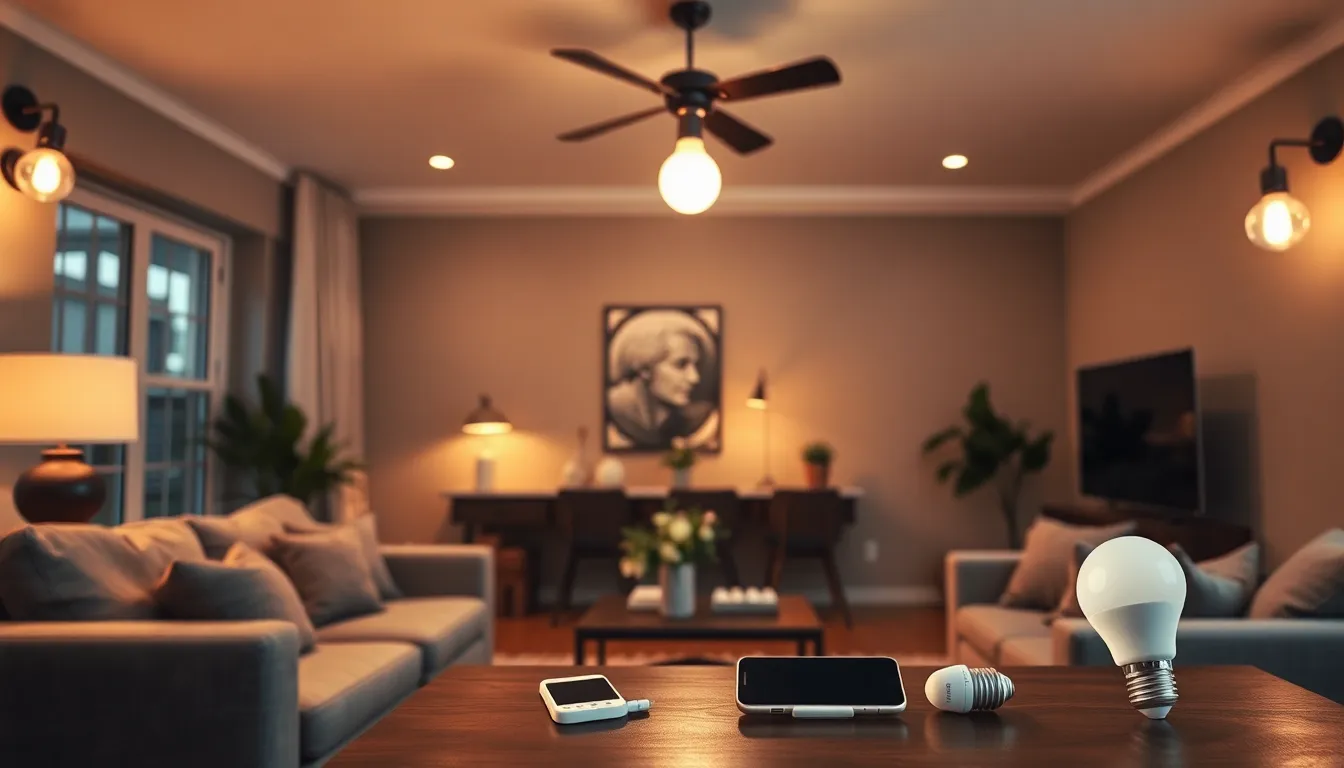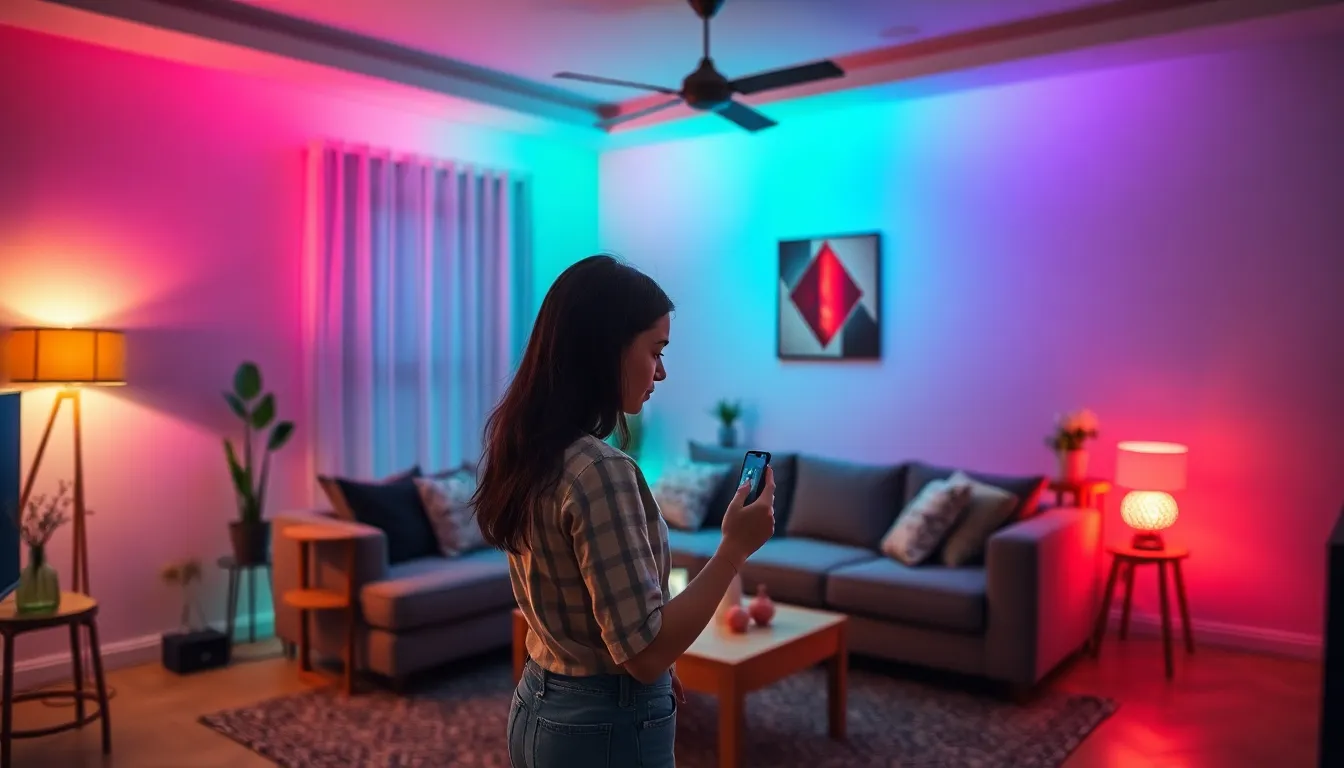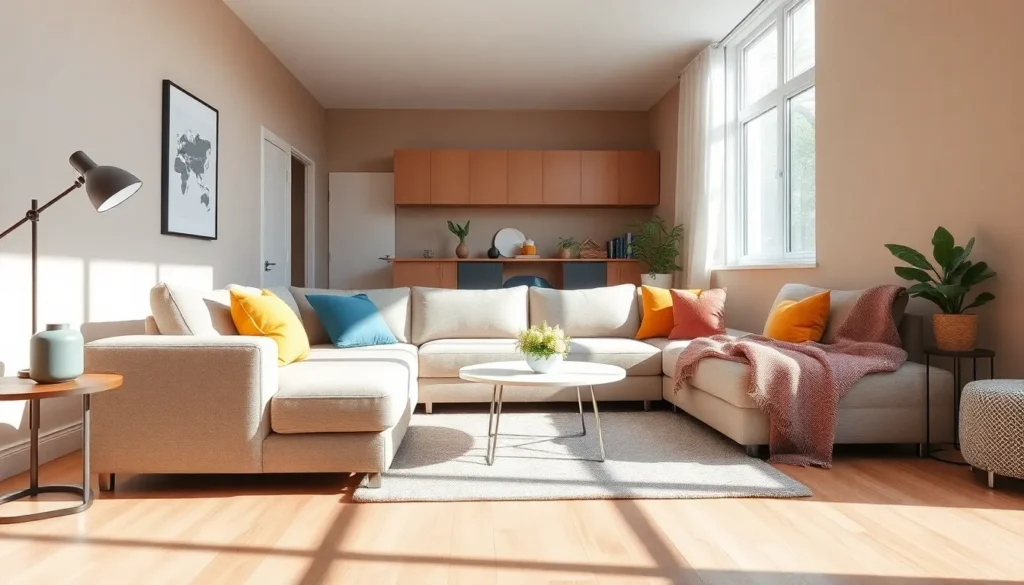Imagine walking into a room and having the lights greet you like an enthusiastic puppy. Smart lighting solutions do just that and more, transforming mundane spaces into vibrant environments. With the flick of a finger or a simple voice command, they adjust to your mood, schedule, or even the time of day—no more fumbling for switches in the dark!
Table of Contents
ToggleOverview of Smart Lighting Solutions
Smart lighting solutions integrate advanced technologies to create adaptable, efficient environments. Users benefit from the ability to adjust lighting based on specific needs, such as mood or activity. These systems utilize sensors and controls that respond to human presence, time of day, and natural light levels.
Energy efficiency stands out as a critical advantage of smart lighting. Many solutions leverage LED technology, which consumes up to 75% less energy than traditional incandescent bulbs. Cost savings emerge as a direct result, with reduced energy bills contributing to lower household expenses over time.
Flexibility defines smart lighting. Users can control their lighting remotely through smartphones or voice commands, offering ultimate convenience. Customizable schedules allow lighting to adjust automatically, ensuring spaces are well-lit when occupied and saving energy when empty.
Compatibility remains an essential feature of smart lighting systems. Many products work seamlessly with existing smart home ecosystems, including platforms like Amazon Alexa, Google Assistant, and Apple HomeKit. This compatibility enables users to create interconnected environments that enhance overall functionality.
Safety and security also benefit from smart lighting solutions. Automated lighting can simulate occupancy, deterring potential intruders by creating the appearance of an occupied home. Additionally, pathway lighting can illuminate dark areas, preventing accidents and improving visibility.
The growing market for smart lighting solutions reflects the increasing demand for energy-efficient, user-friendly options. As technology advances, these systems continue to evolve, providing enhanced features that cater to diverse consumer needs. Exploring smart lighting options can lead to improved comfort, convenience, and sustainability in everyday life.
Key Features of Smart Lighting Solutions

Smart lighting solutions offer a range of innovative features that enhance convenience and efficiency in everyday environments.
Energy Efficiency
Energy efficiency stands out as a primary benefit of smart lighting solutions. Many systems utilize LED technology, which consumes up to 75% less energy than standard incandescent bulbs. Utilizing sensors and timers, these lights automatically adjust based on occupancy or natural light levels. This intelligent operation not only reduces energy consumption but also lowers monthly utility bills. Smart lighting can lead to significant savings over time, making it an eco-friendly choice. Additionally, some solutions come with energy monitoring capabilities, allowing users to track usage patterns and make informed decisions on lighting settings.
Enhanced Control Options
Enhanced control options provide users with a flexible and intuitive experience. Many smart lighting solutions integrate seamlessly with smartphones, enabling remote operation from any location. Voice control compatibility adds another layer of convenience, allowing users to change settings using simple commands. Customizable schedules allow individuals to plan when lights turn on or off, adapting to their daily routines. Furthermore, various preset scenes can be created for different activities, like reading or entertaining, instantly transforming the ambiance. User-friendly apps allow for easy adjustments, ensuring optimal lighting experiences tailored to personal preferences.
Types of Smart Lighting Solutions
Smart lighting solutions come in various forms, each offering unique features and benefits. These options cater to diverse preferences and needs, enhancing the overall experience of lighting control.
Smart Bulbs
Smart bulbs connect to Wi-Fi or Bluetooth networks, allowing for easy remote control. These bulbs emit adjustable colors and brightness, creating tailored atmospheres for different activities. Users can control them through smartphones or voice commands, making access convenient. Energy-efficient LED technology typically powers these bulbs, reducing energy consumption significantly. Many smart bulbs integrate seamlessly with home assistant platforms, ensuring compatibility across devices. Some models offer features like scheduling and automation, syncing with users’ lifestyles effortlessly.
Smart Switches and Dimmers
Smart switches and dimmers replace traditional wall switches to provide advanced control over existing lighting fixtures. Users can adjust brightness levels to set the perfect mood without the need for smart bulbs. Various models connect to home networks, enabling operation through mobile apps or voice assistants. Flexibility in setting schedules or controlling multiple lights at once enhances user experience. Additionally, these devices often feature energy monitoring capabilities, allowing users to track energy usage effectively. Compatibility with traditional lighting systems makes for easy installation and upgrading.
Smart Lighting Systems
Smart lighting systems encompass multiple components, including bulbs, switches, and sensors, to create a comprehensive lighting solution. These systems can be programmed to react automatically to environmental changes, such as adjusting light levels based on sunlight. Various sensors detect occupancy and adjust lighting to save energy when spaces are unoccupied. Users benefit from centralized control through mobile apps or dedicated hubs, streamlining the management of all lighting elements. Integration with other smart home devices provides enhanced automation capabilities, optimizing user convenience and comfort.
Benefits of Using Smart Lighting Solutions
Smart lighting solutions provide remarkable advantages for users, enhancing both their daily routines and overall well-being. Through their advanced features, these systems ensure convenience and security.
Convenience and Comfort
Smart lighting promotes effortless control over household environments. Users can adjust brightness and color with a simple tap on their smartphones or via voice commands. Customizable schedules tailor lighting to personal preferences, illuminating spaces when occupied. Imagery of dimming lights creates cozy atmospheres during movie nights. Accessibility improves with remote capabilities, allowing users to manage lighting from anywhere. Quick adjustments accommodate changes throughout the day, adapting to natural light levels or user activities.
Home Security Enhancements
Smart lighting significantly boosts home security measures. Simulation of occupancy deters potential intruders, as lights automatically turn on and off at designated intervals. Motion-activated lights illuminate dark areas, providing safety during nighttime. Integration with security systems enhances overall awareness, alerting homeowners to activity in their surroundings. Remote monitoring options allow users to control lights while away, maintaining the appearance of an occupied home. These sophisticated solutions make properties less appealing targets, promoting peace of mind for residents.
Smart lighting solutions represent a significant advancement in creating comfortable and secure living spaces. By integrating energy-efficient technologies with user-friendly controls, these systems not only enhance convenience but also promote sustainability. The ability to customize lighting based on individual preferences and routines ensures that every environment can be tailored for maximum enjoyment and efficiency.
As the market for smart lighting continues to grow, homeowners are increasingly recognizing the value of these innovative solutions. With features that prioritize safety and adaptability, smart lighting is more than just a trend; it’s a practical investment in a brighter and more efficient future.




